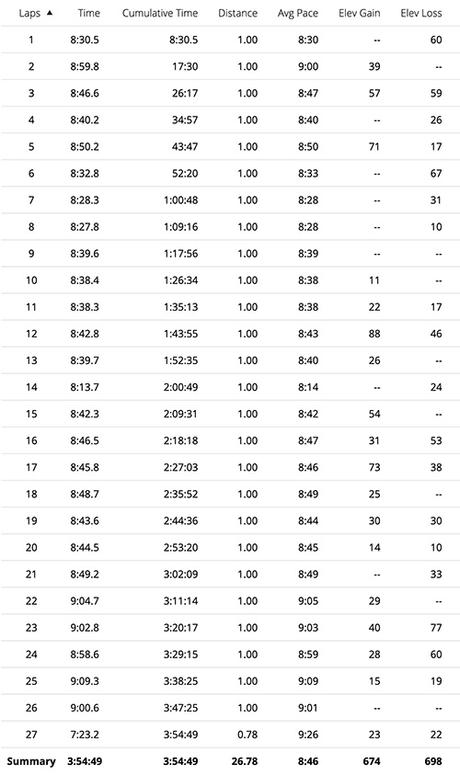It winds from Chicago to LA
More than two thousand miles all the way
Get your kicks on Route 66.
– “(Get Your Kicks On) Route 66,” Bobby Troup (1946)

Ladies and gents, we have a milestone! (No pun intended, for once.) With this race report, I’ve reached 💯 blog posts—and I hate to imagine how many words—here on Blisters, Cramps & Heaves. And while 100 certainly isn’t a number I ever envisioned when I started 8½ years ago, I daresay I’m enjoying the process at least as much now as I did then—it’s more satisfying than social media and cheaper than therapy. In a world of vanishingly short attention spans I realize this blog is the opposite of Twitter, and I like to think that’s a good thing. Thanks for sticking around and joining me on the journey!
With the all-consuming presidential election finally over and American democracy safe for at least another week, I want to end a dreadful 2020 on an upbeat note by immortalizing my final marathon of 2019 before the calendar flips to 2021 (apologies if that sentence read like something from Back to the Future IV: Spirit of the Marathon). Because as it turns out, if you’re looking to end the racing year on a high note, it’s tough to do better than Tulsa.
Three weeks after the Marshall University Marathon in West Virginia, Katie and I found ourselves in chilly Northeast Oklahoma for what would be my 5th state of the year and my 30th overall at the Williams Route 66 Marathon. Even better, we (meaning RaceRaves) would be joining “Oklahoma’s biggest block party” as an exhibitor at the two-day expo preceding the race, where we’d meet runners from across the state and around the country (Route 66 is one of the more popular marathons in the U.S. and a favorite among 50 Staters). Because nothing says “marathon taper” like being on your feet all day for two straight days! Luckily, I’d very much been looking forward to this weekend. And it wouldn’t disappoint.
With race day on Sunday, Friday and Saturday were spent working for the weekend and walking one of the most enjoyable expos in the country. Complementing its energetic vibe, the Route 66 expo featured plenty of relevant booths without (to quote fellow 50 Stater and expo veteran Evelyn) a lot of “pushy salesmen.”
Though I was eager to get out and explore Tulsa, the expo reminded me why I love talking to runners, who typically are more diverse, more interesting and more sociable than the folks I used to meet at scientific conferences. Manning our booth for two days, we met friends old and new including Tulsa resident, fellow Rice Owl and RaceRaves member John P. We’d first met John at the Fargo Marathon in May before reuniting at the Clarence DeMar Marathon in September, and we’d quickly come to appreciate how an outgoing, good-natured fellow like John had earned himself the tongue-in-cheek moniker of “The Mayor of Tulsa.”
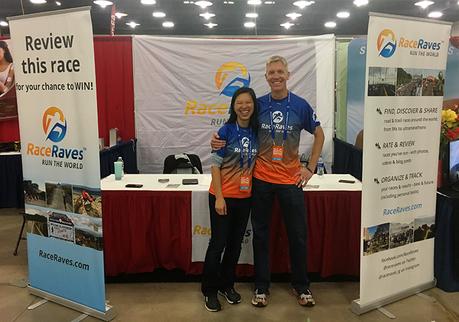
We were likewise joined by Shilpa, whom we’d met at the Tokyo Marathon in March and who had told us she’d be making the two-hour drive from Oklahoma City and “bringing a friend.” She then surprised us by showing up on Saturday alongside another of our favorite human beings in fellow Antarctica adventurer and Tokyo mate Louann. As if seeing the two of them together weren’t enough of a kick, they wasted no time grabbing a handful of flyers and evangelizing zealously to any passerby within earshot, telling them why RaceRaves was the missing secret ingredient in their lives. All while Katie and I sat behind the booth happily admiring and appreciating their salesmanship.
Saturday evening, with expo duty behind us, our focus turned to race day as the four of us—Katie, Louann, Shilpa and me—joined John and his wife Jen at their home for one of the most enjoyable pre-race meals we’ll ever have. Also joining us was the trio of fellow guests whom John would affectionately refer to as the “Yoopers,” since Donna, Laurie and Nancy all hail from the Upper Peninsula of Michigan. Like us, they’d met John in their running travels and were all in town for the marathon. John and Jen graciously hosted a fantastic evening of carbo-loading and camaraderie, highlighted in part by his remarkable portfolio of creatively carved jack o’ lanterns. Trust me, if you’ve never seen David Bowie’s face carved into a pumpkin, you’re missing out.
Later that night, back in our room at the Aloft Tulsa Downtown, it occurred to me as I laid out my racing gear that after a lively two-day expo and a memorable evening with friends, running 26.2 miles the next day might actually feel—anticlimactic.
Fortunately, as happens once or twice a year, I was mistaken.
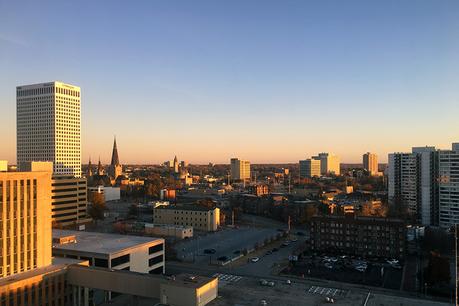
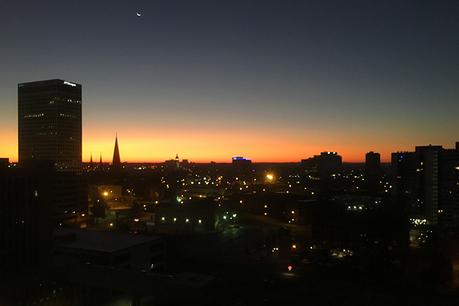
Tulsa, here we come (Start to mile 7)
Location, location, location. As advertised, the Aloft was located less than ten minutes (on foot) from the marathon start line, which as it turns out wasn’t quite as convenient as the Holiday Inn located 100 yards from the start where Louann and Shilpa were staying.
We met them on Sunday morning in the lobby of the Holiday Inn in plenty of time for the relatively late 8:00am start. I’d slept well after our busy two-day expo-rience; fortunately, I’ve run enough marathons now that I’m largely past the point of pre-race jitters. So sleep usually isn’t an issue unless the wakeup call comes brutally early, as in the case of the Comrades Marathon in South Africa which demands (and receives) a 2:00am wakeup. ‘Cuz if you plan to run 90 km in a day, you best get an early start.
With Thanksgiving just four days away, the morning was understandably chilly but otherwise perfect with clear, cerulean skies and just the hint of a breeze. This was autumn at its finest and the type of morning that looks stunning in pictures. Luckily, I’d be taking a few today.
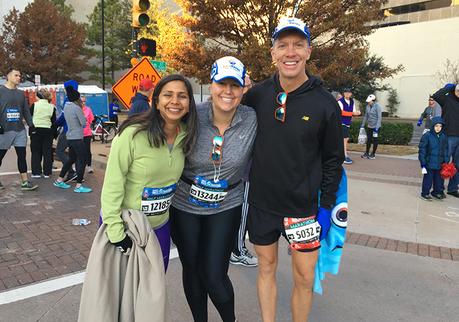
After a quick group picture, we each headed to our respective start corrals. I’d be running the full marathon while Louann and Shilpa would each be tackling the half, a fact that Shilpa—who’s run 120+ marathons in every state and on every continent, including both poles—made sure to remind me of one last time. She urged me to listen for her at the midway point, where the marathon and half marathon courses split and where she’d be the voice yelling, “SEE YA, SUCKERS!” at the marathoners. I hoped she wouldn’t get herself either arrested or chased off the course before I got there.
Another highlight from the expo had been a chance encounter with Route 66 race announcer Rudy Novotny, a high-energy guy and a well-known face/voice in the industry. Rudy had dropped by our booth to say hi and introduce himself, and on hearing I’d registered late and been assigned to start corral “D” at the back of the pack, he’d excused himself for a couple of minutes and then reappeared with a corral “A” sticker, which now lived proudly on my bib number. A super-cool gesture on his part. Now, as I listened to his familiar voice energize the restive crowd over the PA, I visited the raised stage alongside the start line to give Rudy a shout-out and a wave before retreating to my much-appreciated spot in the “A” corral.
Feeling good I bounced up and down in place, loosening my legs and craning my neck to witness the Native American drum ceremony at the start line followed by an a cappella singing of the national anthem. As I joined in the applause I took a deep breath, soaking up the morning and calming any last-second nerves as the hand cycle and wheelchair athletes crossed the start line. Let’s do this.
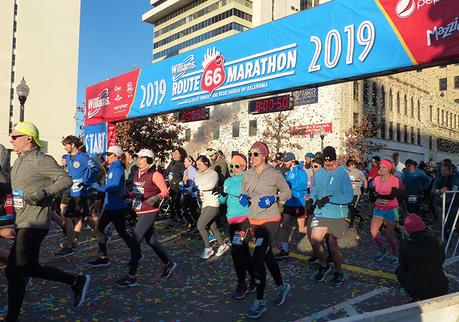
I was roughly 50 yards behind the start line when the famed Route 66 confetti gun fired, signaling the start of the race. Hmm, I thought as the first wave of runners surged forward, confetti raining from the sky. That was cool I guess, but not really the big deal I expected. Then the confetti continued to fall.
And fall.
And fall.
Turns out the Route 66 confetti gun is more of a confetti hose, with every starter in corral “A” (and presumably those in the following three corrals as well) being showered in colorful confetti as they crossed the start line. Much like runDisney with its start-line fireworks, this was a fun way to begin the race and one that embodied the all-inclusive Route 66 spirit of every runner matters.
Immediately the course headed away from downtown, and I felt amazingly good as I reflected on our RaceRaves success of the past week. Among other things, we’d published the results of our Runners Choice: Best Half Marathons in the U.S. initiative two days before hopping a plane to Tulsa for race weekend, and now the holidays lay ahead. So this was a great time to give thanks.
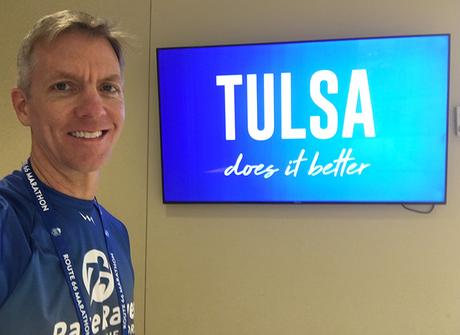
My carefree mindset translated to an unexpectedly effortless stride—a bit too effortless in fact, and if my Garmin could talk, at that moment it would have howled at me to Slow down, stupid! Glancing at my wrist I saw an average pace of 7 somethin’ somethin’ minutes; so much for the adage that the slowest mile of any marathon should be your first. Thing is, after two days on my feet I had no intention of chasing a Boston Marathon qualifying time across Tulsa, and I quickly dialed back my pace so that by the time we reached the first mile marker, I was clocking a much more reasonable 8:30/mile.
Transitioning from commercial to residential along a tree-lined stretch of E 15th St, we entered the first of several charming neighborhoods. Here a sign welcomed us to the “Maple Ridge Mile” and let us know that if we’d forgotten anything (gloves, Vaseline, etc.), it would be available directly ahead of us. Sure enough, seconds later we passed a table where gloves and other goodies were laid out for the taking. And with that, we were introduced to Route 66 hospitality. (There’d be plenty more to come.)
I was careful to maintain a comfortable pace as we cruised past nicely manicured lawns and handsome homes that, architecturally speaking, were surprisingly diverse. Turning left onto E 21st St we passed the Skelly House, one-time home of oil tycoon William G. Skelly and now the residence of the University of Tulsa president. The home is also listed on the National Register of Historic Places.
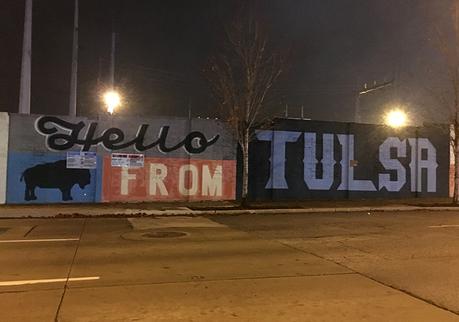
In mile 3, with many runners still finding their groove, we were introduced to a hugely popular hallmark of the Route 66 Marathon—the “unofficial aid station.” Unlike official race aid stations which offer predictable marathon hydration like {yawn} water and Gatorade, frequent unofficial stations are set up along the Route 66 course—often in front yards—as a labor of love by the locals; these typically feature much more diverse and de-hydrating (read: alcoholic) options.
At this particular dehydration station we were greeted by a jovial group of spectators relaxing alongside a table of drinks. “Bloody Marys!” one offered as we passed. Yikes, I thought instinctively. If you’re stopping for a Bloody Mary at mile 3 of a marathon, you’ve got a looong day ahead of you. On the other hand, by mile 20 you’d probably be feeling very little of the pain the rest of us would be fighting through.
The next five miles featured a delightful tour of upscale neighborhoods that showcased high-end homes set back from the road by sprawling, well-kept lawns and lengthy driveways. Mile 5 began alongside the gated grounds of the Philbrook Museum of Art before ending in expansive Woodward Park, itself a recent addition to the National Register of Historic Places. Briefly diverging from this residential route, a ¾-mile stretch on Peoria Ave led us past shops and restaurants including the most official unofficial aid station of the day, the 3 Tequilas Mexican restaurant. One tequila, two tequila, three tequila, FLOOR.
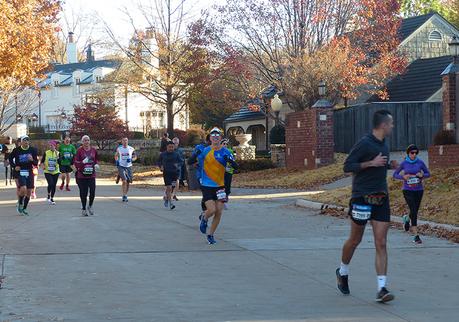
Meeting the Mother Road (Mile 8 to midway point)
Heading west we ran (figuratively) into the Arkansas River, where a right turn led us north along Riverside Dr for the next three miles. “Eye of the Tiger” (finally!) blasted from a balcony to our right, and a tent alongside the course played Bell Biv Devoe’s “Poison,” which oddly enough I’d just heard three weeks earlier at the finish line in West Virginia after not hearing it for years. Was the song making a comeback? Had Bell, Biv or Devoe won The Masked Singer? I doubted all three of them could fit into one of those garish costumes together.
Running parallel to the river on closed roads was a course highlight even before we reached The Gathering Place, a world-class riverfront park voted “Best New Attraction of 2018” by USA Today. Not surprisingly, running past without stopping isn’t the best way to appreciate Tulsa’s hottest new family attraction, and especially given the two tunnels along Riverside Dr which actually routed us below The Gathering Place. Fortunately, Katie and I made time on our way out of town the next day to return and explore the park a bit. It’s ambitious to say the least.
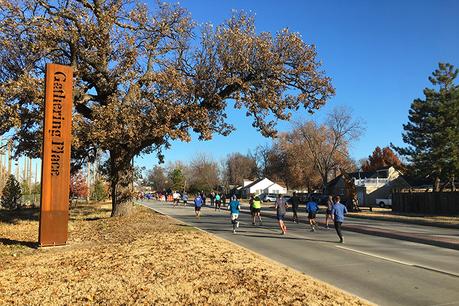
Onward we ran, the smokestacks visible across the Arkansas River giving way to a steady line of tree cover—and beyond that, the hidden sights and sounds of West Tulsa. As we approached two spirited young volunteers with bullhorns, one of them called out “KNOCK KNOCK!”
“WHO’S THERE?” asked the other, to which the first responded, “MOO!”
“MOO WHO?” her fellow volunteer and I inquired in unison. I braced myself—this was gonna be good, I could tell. Then a moment of silence, and as I passed her the first volunteer blurted out, “WAIT, I MESSED UP!” Laughter ensued, so at least the joke had its desired effect. And as this a-moo-sement faded behind me, the last thing I heard was: “KNOCK KNOCK!” “WHO’S THERE?” ”COW!”…
Reaching the end of Riverside Drive, we turned left for a short out-and-back across the Arkansas River on the Mother Road itself—this stretch of less than a mile would be the lone segment of the marathon course to follow the original Route 66.
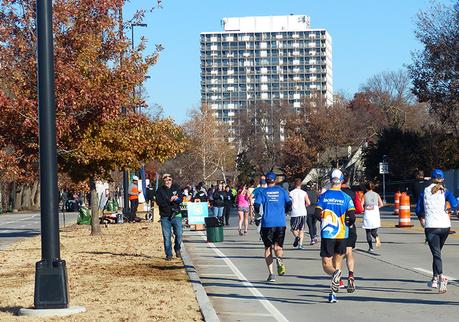
Search for Route 66 on a map today, and you’re likely to be disappointed. Established in 1926 to connect Chicago and Los Angeles as part of the original U.S. Highway System, Route 66 was instrumental in Tulsa’s growth and development before it was decommissioned in 1985. The route was the brainchild of Tulsa businessman Cyrus Avery, who recognized the potential economic impact of a federal highway system and who would later be known as “The Father of Route 66.”
One of the determining factors that enabled the passage of Route 66 through Tulsa was the existence of the 11st St Bridge across the Arkansas River, which connected Downtown Tulsa to the oil fields to the west and which Avery himself played a pivotal role in constructing. Though now in disrepair and closed to vehicular and pedestrian traffic, the bridge was added to the National Register of Historic Places in 1996 and renamed the “Cyrus Avery Route 66 Memorial Bridge” in 2004. The structure would eventually be deemed “too expensive to repair, too historic to demolish, and too valuable to ignore;” as such, it remains standing alongside the Southwest Blvd bridge on which we now ran. Unless you know it’s there, however, you could be forgiven for failing to notice its presence, much less appreciate its significance. And especially in mile 12 of a marathon.
Retracing our steps across the Arkansas River and heading back toward downtown, we ran beneath the historic Route 66 sign overlooking Cyrus Avery Centennial Plaza—the man got his props from the city, no doubt about it.
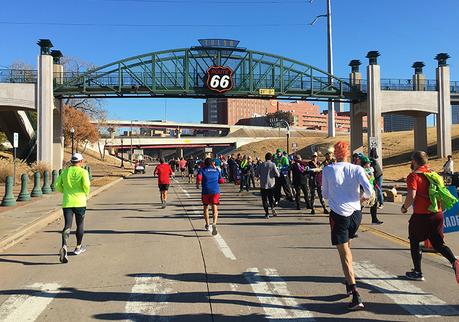
As if leaving Route 66 was our cue to get back to business, the course immediately headed up another short but nasty incline. As I was discovering the hard way, the Route 66 course has more than its share of hills what Marathon Executive Board Chairman Tim Fisher likes to call “character.” And that character was now threatening to suck the life out of my tired legs.
My Garmin’s mile alerts gradually fell further and further behind the official mile markers, which is typically the sign of a well-measured course. It’s when my GPS suddenly gains or loses half a mile relative to the official markers that I start to worry about course measurement. I wouldn’t have to worry in Tulsa.
I quickly lost track of the number of unofficial aid stations along the course, though Shilpa counted ten on the half marathon course alone. (This is in large part because the marathon and half marathon courses share the first 13 miles, hence more runners.) Beer, fireball (whiskey + cinnamon) shots, Jell-O shots and other adult beverages were happily being served, and as I passed one table covered with assorted bottles of liquor, I was reminded that John likes to roll up on aid stations—which usually means a friendly volunteer proffering a cup of water or Gatorade—and ask good-naturedly, “What’ve we got, bartender?” Now I understood that here at his hometown race, this was a legitimate inquiry.
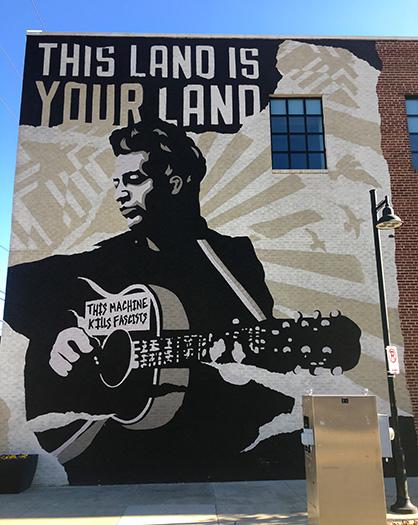
Don’t get me wrong; yes, I’ve (over)emphasized the unofficial aid stations to this point, but Route 66 also features plenty of “Official Block Party” tents and aid stations plus other helpful reminders—case in point the official race sign reminding runners to “Drink water first” and “DO HYDRATE.”
I can barely stomach one ounce of energy gel during a marathon, so alcohol certainly wasn’t happening; nonetheless, I keenly appreciated the lively local support. And if that’s how other runners choose to enjoy their race, more power to them—my enjoyment comes from reaching the finish line as quickly as possible while staying attuned to my surroundings. I don’t need to stop and interact with the course to appreciate its charm and quirkiness, but I can understand the appeal. And especially in the case of Route 66’s unofficial aid stations, which arose organically as an innovative way for residents to take part in race day, rather than out of any operational “spontaneity” on the part of race officials.
Passing the BOK (Bank of Oklahoma) Center in Downtown Tulsa the marathon course split from the half marathoners, and I heard Shilpa’s heckling in my head as we turned uphill into a slight headwind, our first of the day. Welcome to the next 13 miles, the course seemed to say. With an exasperated sigh, the woman running next to me said, “I should’ve run the half.” I laughed and told her I planned to enjoy this second half. Then I powered up the hill, intent on escaping the towering shadows that had usurped the soothing warmth of the late-morning sun.
Still I felt good as we passed the 13.1-mile mark in the city’s Blue Dome entertainment district. Here the roads became rougher and the course more commercial. Most of the roads along the course were relatively smooth and well maintained, though as with any urban race there were times when I felt the need to stay vigilant for cracks and potholes. Luckily, such sections were few and far between.
Halfway home.
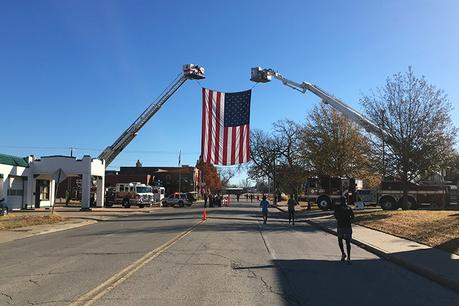
Rollin’, Rollin’, Rollin’ (Midway point to finish)
Along with the hills, the other aspect of the Route 66 course that discourages speedy finish times is its sheer number of turns—there are a lot of turns, with the three miles along the Arkansas River being the longest uninterrupted stretch of the day. The course’s convoluted layout made running the tangents (i.e., the shortest possible distance from start to finish) nigh impossible, but it did keep things interesting while doing nothing to impede my enjoyment.
Just after mile 14 (and again at mile 24) we passed Oaklawn Cemetery. As if being a cemetery weren’t ominous enough, Oaklawn made national news recently as the site where a forensic team excavated at least 12 coffins in its search for victims of the 1921 Tulsa race massacre, in which as many as 300 Black residents were killed and the prosperous Black neighborhood known as “Black Wall Street” was destroyed. None of us blithely running past Oaklawn (twice) on that crisp November morning had any idea of our proximity to a mass grave, of course, but even in retrospect the thought is chilling.
It was around the midway point that two days at the expo began to catch up with me as my right hamstring tightened a bit, followed by my upper right quad in mile 16. I wasn’t overly concerned since a) I’d expected this and b) neither ache affected my already conservative pacing, though they didn’t exactly make running more comfortable, either. Luckily I knew that as soon as I crossed the finish line, I’d be taking a break from marathons for at least the rest of the year.
After sitting out West Virginia three weeks earlier, Katie made up for lost time with appearances at miles 6, 9, 15.5, 20 and 25.5, not to mention both the start and finish. In other words, she was everywhere—everywhere except, ironically enough, on Route 66.
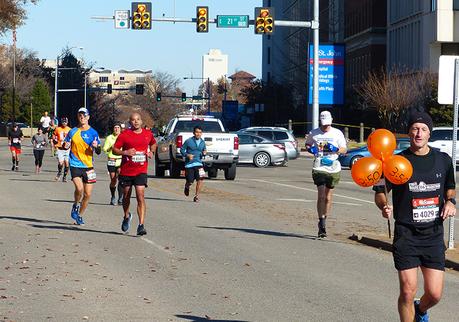
On-course musical entertainment included live acts such as a memorable honky-tonk band in the early miles and classic go-to favorites like “Eye of the Tiger.” One unofficial aid station greeted us with “Sweet Home Alabama,” and I was disappointed not to hear any spectators or volunteers step up and seamlessly substitute “O-kla-HO-ma” in the chorus. Talk about a missed opportunity.
With every race I run, it becomes harder to find new signs I appreciate—creative marathon humor seems to be in short supply. And yet in Tulsa I did see:
“This parade is too fast” (a welcome riff on the tired “Worst Parade Ever”)
“You’re the slowest runner yet!” (which sounds insulting at first blush but which was simply true)
“You’re running better than the government” (a personal favorite I’ve seen with increasing frequency the past few years)
Owing to the lack of half marathoners (who outnumbered marathoners in Tulsa nearly 3:1), spectators were understandably more sparse in the second half. This is typical in races like Route 66, where half and full marathoners share a course for the first 13-ish miles. It also meant the organizers had saved the best for first, meaning a more scenic and attractive first half. Indeed, the second half featured a steady diet of pleasant but forgettable neighborhoods, although in their defense late November isn’t the best “dress to impress” time of year with both grass and trees sporting monochromatic brown wardrobes. And while I still appreciated these neighborhoods (since too many marathons rely on monotonous second halfs), I didn’t feel the need to admire each and every one as I struggled to maintain pace.
The hands-down highlight of the second half arrived in mile 21 as we reached the University of Tulsa, which we entered via a smoothly paved, tree-lined semi-oval before circling the campus. I know nothing of its academic programs, but from an architectural perspective TU was newer and more impressive than Marshall had been. And its shrewd placement here in two of the most difficult miles of any marathon was a much-needed distraction.
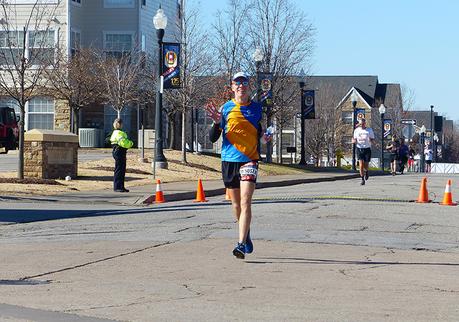
Every urban marathon has its nondescript patches, its less scenic sections that feel inevitable in the search for 26.2 miles. In Tulsa this was the two mile-stretch after the university, as we navigated homeward past the usual lineup of fast food, pharmacies and bail bond shops. By that point, though, scenery mattered not as my attention was focused largely on the tops of my shoes.
Heading west we enjoyed our second-longest straightaway of the day, and suddenly it hit me how tired I was of making turns. Running straight ahead with no immediate turn in sight felt good, and my fatigue lifted momentarily with the realization of having less than 5 km to go.
Glancing left I couldn’t help but notice the prominent spires of Parish of Christ the King, an eye-catching example of Tulsa’s proud Art Deco architectural tradition. And as we turned north onto S Peoria Ave (thus completing a nine-mile loop), I appreciated the view of Downtown Tulsa beckoning us in the distance while feeling beyond grateful not to be an oncoming runner on the other side of the road with 10+ miles still ahead of me. 😓
Thanks to the cold weather, my bottle of Maurten sports drink—which I’d grabbed from Katie in mile 16 and which I’d sip on until mile 23—would be all I’d need to fuel my morning run, and so the only time I’d use an (official) aid station would be to grab a cup of water and rinse off my hands, since my fingers were more or less stuck together after sloshing sugar water on them for seven miles.
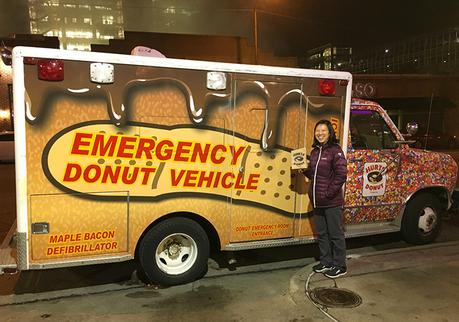
As running mantras go, “Roll with it” might be the best choice for Route 66. The course seemed intent on flexing its muscle, and as one hill led to another and with each descent seemingly followed by a corresponding ascent, I battled to maintain pace and avoid walking. More than anything I wanted to stop and walk, but I also knew that walking 50 yards would quickly lead to walking 100 yards would lead to “Who cares if I break four hours?” would lead to an unhappy finisher. So I forced myself to keep pushing through muscle tightness, mounting fatigue and my general bitterness with Tulsa’s ups and downs.
On a couple of the ups I trailed a woman wearing a singlet that read on the back, “Does this pace make my butt look fast?”. As much as I wanted to encourage her since she looked to be struggling, I didn’t want to invite a misunderstanding by cheekily (no pun intended) responding in the affirmative; besides, chances were good her marathon-fogged brain wouldn’t appreciate the reference anyway. So instead I gasped out my usual “Nicely done” and flashed a thumbs-up as I huffed and puffed my way past her up the hill.
At long last I passed the mile 25 marker and soon after arrived at a Route 66 exclusive—the Center of the Universe detour. Billed as the “World’s Shortest Ultra Marathon” for folks who “wish those 26.2 miles were actually a little longer,” Route 66 offers a 0.3-mile detour to what the city hails as the “Center of the Universe,” an unexplained acoustical anomaly that acts as your own private echo chamber. The detour is entirely optional (though I can’t imagine running the race as a first-timer and not taking it), and for their efforts runners receive a commemorative coin to complement their finisher’s medal.
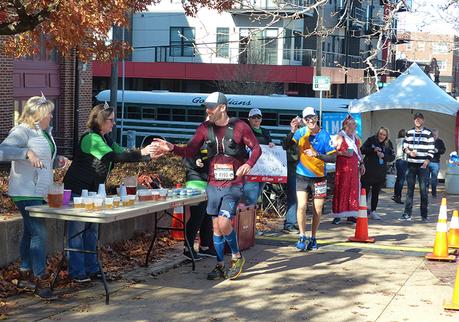
Of course, this wouldn’t be Tulsa if the road leading to the COTU weren’t uphill—and not just uphill, but among the steepest of the day. Silently I thanked/cursed John for omitting this detail. I fought up the hill, feeling like one of the concrete pillars lining the road as I tapped into my fast-dwindling energy reserves. I knew not where the actual COTU was, nor did I much care—there’d be time to appreciate that later—and in the space of a few feet I passed Katie, the COTU and Destiny Green, the Marathon’s Executive Director, who was apparently there in part to cheer on her mom.
Reaching the turnaround I gratefully accepted my commemorative coin, made the turn past “Miss Fortune” (one of the detour’s famed drag queens… did I mention Route 66 is a shameless party?), and headed back the way I’d come. I was completely oblivious to the “ONE MILE TO GO” banner that apparently hung overhead, my mind laser-focused on the finish line.
I seemed to take forever to get there. At this point I knew sub-four hours was in the bag, and so I wasn’t in any real hurry to finish, but still I refused to walk. Mentally I expected (unrealistically) to see the finish line the moment I left the COTU, and so the final mile felt more like five, with four more turns between me and my destination. Every time I glanced up hoping to see the finish, I’d see runners ahead of me disappear around another turn. Past the BOK Center and up one last hill we trudged as a volunteer with a megaphone announced, “You’ll be disappointed to hear this is the last hill,” to which a woman to my left replied with a squeal, “YOU’RE MY FAVORITE PERSON ON THIS ENTIRE COURSE!!!”
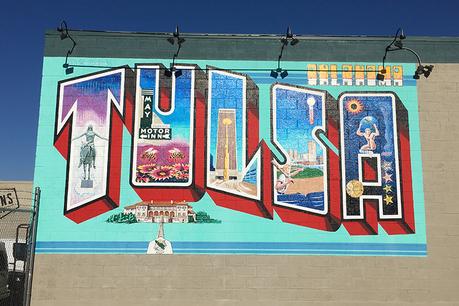
Three blocks later we reached that long-overdue beacon of hope: the mile 26 marker. Just beyond that, a sky-blue Tulsa vintage postcard mural on N Boulder Ave welcomed us to the city’s Arts District while reminding us who had hosted this crazy li’l shindig.
If you’ve never experienced the indescribable joy of turning a corner and seeing a marathon finish arch dead ahead, then you are missing out. It’s an emotion I wish I could bottle and share. This is especially true in Boston, where once you make that final left turn onto Boylston you have nearly half a mile of straightaway to bask in your accomplishment along with the crowd’s adulation. In Tulsa, that feeling of euphoria washed over me as I turned onto W Cameron St and applauded the cheering spectators who lined the right side of the home stretch. High-fiving Katie and a few others, I proudly held up my coin and heard my name announced by OKC native Mark Bravo’s familiar voice as I crossed under the red and blue finish arch in a very acceptable time of 3:54:47, having cleared the four-hour barrier with room to spare.
I’d rocked the Route, and it had rocked me right back.
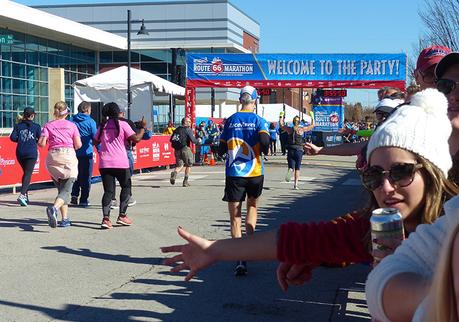
Oil’s well that ends well
As usual after my last marathon of the year, I was wiped out. And though I didn’t feel as gassed as I had after the Jacob Wells 3 Bridges Marathon in 2018 or CIM in 2014, still I was psyched to be done. With five new states plus a World Marathon Major in Japan and an iconic ultramarathon in South Africa, 2019 had been a wildly successful racing year.
I took a moment in the finish chute to gather my wits, wanting to throw my arms around Tulsa and give the city a massive hug. Gratefully I accepted my finisher’s medal along with a bottle of water and Gatorade (munchies such as Mazzio’s Pizza were also available, but I just couldn’t) and then headed for the exit where I took out my elation on Katie, throwing my arms around her as we celebrated 30 states down, 20 to go. She even bought me a “26.5 Finisher” t-shirt at the Fleet Feet Tulsa tent, which I’m now wearing as I write this.
Slowly I diffused over to Guthrie Green, a lovely urban park and ideal post-race venue. Drew and Louann—close friends from our Antarctica trip who hadn’t realized each other would be in Tulsa—had finished the half marathon and were relaxing on the grass soaking up the afternoon sun while an 80s cover band entertained the crowd onstage. Apparently Shilpa, confident and content to rest on her marathon laurels, had failed to respect the half marathon distance and was now resting on her hotel room bed instead after her own 13.1-mile effort.
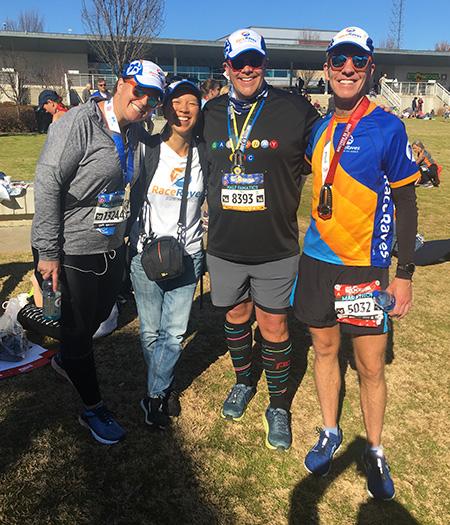
I could have fallen asleep right there on the warm grass myself, but the three of them needed to hit the road soon, so we made plans to shower and reconvene for a quick lunch. Before leaving the scene of the crime, though, I checked out the VIP room in the adjacent Zarrow Center, a sweet perk for 50 States Marathon Club members. There a massage therapist prodded my distressed quad and told me my SI joints were misaligned, which could account for recurring glute and hamstring pain on my right side. I made a mental (and now physical) note to look into it.
I couldn’t leave without cheering Mississippi buddy and fellow 50 Stater Evelyn across the finish line. As I waited, a couple of runners approached the finish wearing “TEAM BEEF” shirts, and I applauded their effort as I silently high-fived myself. Always a good day when a vegetarian can beat Team Beef, I thought wryly. I knew that Evelyn, being a vegan herself, would approve.
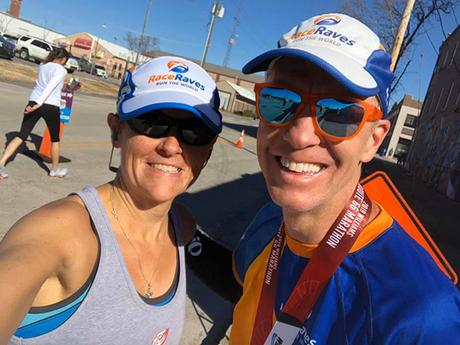
Drew likewise stopped to cheer on a friend to the finish, though he was rewarded with a bitter “Fuck this race!” And Katie shouted encouragement to another woman who responded with, “Running’s dumb!” Nowhere does the human spirit shine quite so brightly as at a marathon finish line.
We met Drew, Louann and Shilpa for lunch at Fat Guy Hamburgers, located in the Greenwood District. Known in the early 20th century as “Black Wall Street,” Greenwood was the site of the 1921 Tulsa race massacre. On this day, though, Fat Guy was the perfect spot for a celebratory lunch with three fabulous people (& Katie) who I never would have met were it not for my good fortune in being able to see the world 26.2 miles at a time.
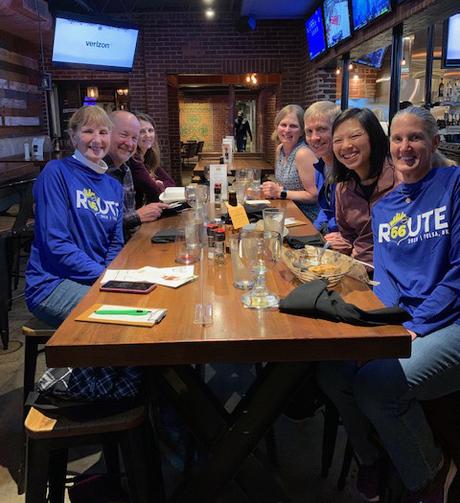
The same would be true of our evening meal as we gathered with John, Jen and the three Yoopers—each of whom enjoyed her Route 66 experience, hills and all—for dinner and drinks at Bricktown Brewery. John is a self-made expert in “post-race pain management” (i.e., he’s a brewpub connoisseur), and Bricktown did not disappoint. And that night we said our farewells with the promise we’d all meet again one day soon—and in some cases sooner than others, as we’d bump into Yooper Laurie at The Gathering Place the next day. Luckily Michigan is one of my remaining 20 states once the COVID clouds lift.
Three days later, as we boarded a flight home from Dallas Love Field Airport after a quick Texas stopover to visit family, the TSA agent pulled aside my backpack, rummaged through its captivating contents and extricated my sleek Route 66 Cadillac hood ornament finisher’s medal. “This looked like a knife on the scanner,” he explained. “It does look sharp,” I admitted, my punny humor going unappreciated.
Route 66 was a spot-on choice for my first Oklahoma marathon, and one I’d happily run again. Tulsa won me over with its sights and sounds, its people and places, its angels and demons. And there’s a reason the city recently finished third in our RaceRaves Best Midsize Racing Cities in the U.S. poll. Because while T-Town may be the second largest city in the Sooner State, I’d argue the label “Tulsa, OK” doesn’t do it justice. Tulsa is a vibrant and historic destination, whether you’re running a marathon in every state, chasing nostalgic slices of Americana like the 75-foot-tall Golden Driller or Space Cowboy “Muffler Man” Buck Atom, or romanticizing the “good old days” by driving the Main Street of America from Chicago to Los Angeles.
Because be it on foot or by car, you’ll get your kicks on Route 66.
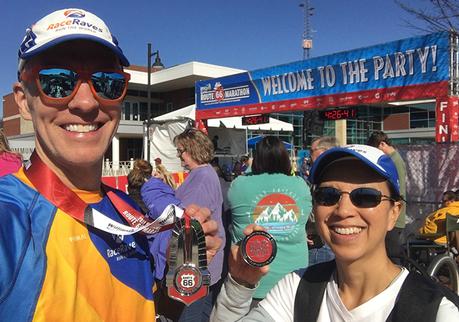
BOTTOM LINE: In a city known for its block parties, Route 66 bills itself as “Oklahoma’s Biggest Block Party”—and it may be right. Though “fun” may not be the first word you associate with the Sooner State, there’s a reason Route 66 is an annual favorite with runners across the U.S. including national clubs like the Marathon Maniacs and Half Fanatics. From its colorful confetti gun start to its popular “unofficial aid stations” to its Center of the Universe detour (earning it the title of “World’s Shortest Ultra Marathon”) to its Arts District finish alongside Guthrie Green, few marathons take care of their runners like Route 66.
Yes, the rolling course boasts its share of hills—or what Marathon Executive Board Chairman Tim Fisher prefers to call “character”—but then again if you run 26.2 miles for fun, chances are you’ll sound a bit silly complaining about a few ups and downs along the way. Besides, there’s no better place to walk off your hard-earned post-race soreness than The Gathering Place, a sprawling urban park along the Arkansas River located in mile 10 that was voted “Best New Attraction of 2018” by USA Today. So then I guess what I’m saying is YES, you really will get your kicks at Route 66.
PRODUCTION: Full disclosure, we spent two days hosting a booth at the Route 66 expo, so I had ample time to pick up my packet and explore the expo. That said, the entire weekend was smooth sailing, and aside from holding the race in Upper Texas (sorry, I grew up in Dallas so the Texas-OU rivalry is still ingrained in me), I can’t recall any memorable glitches or obvious areas for improvement. Great expo, great start line, high-energy (albeit hilly) urban course, a “ONE MILE TO GO” banner that I missed while staring at my shoe tops, plus a comfortable recovery venue after the race in Guthrie Green. Aside from that last dozen or so hills, what’s not to love?
And hills notwithstanding, Route 66 is a great race for first timers—not only for its terrific on-course support but because first-time marathoners and half marathons earn a shout-out on their bibs as well as an exclusive “My First Marathon” or “My First Half Marathon” medal to celebrate their accomplishment.
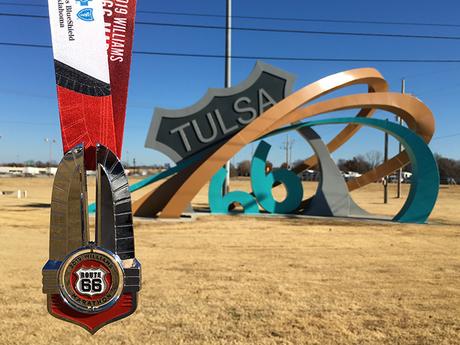
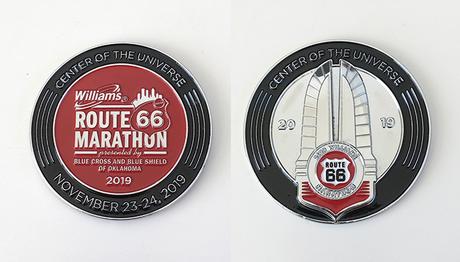
SWAG: Route 66 features some of the best swag out there, including a nicely fitting jacket (for full and half marathon finishers), finisher’s medal (which in 2019 was modeled after a 1940s Cadillac hood ornament), Williams-branded gloves, and even hand sanitizer which turned out to be downright prophetic and the most useful freebie of all. And with a new five-medal series leading up to the event’s 20th anniversary in 2026 and showcasing popular, larger-than-life symbols from along Route 66 in Tulsa (such as Space Cowboy “Muffler Man” Buck Atom), the bling promises to remain a creative conversation starter.
Updated 50 States Map:
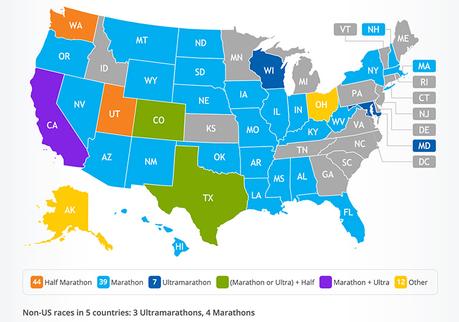
RaceRaves rating:

FINAL STATS:
Nov 24, 2019 (start time 8:00 am, sunrise 7:09 am)
26.78 miles in Tulsa, Oklahoma (state 30 of 50)
Finish time & pace: 3:54:47 (first time running the Route 66 Marathon), 8:46/mile
Finish place: 197 overall, 16/105 in M 40-49 age group
Number of finishers: 1,429 (804 men, 625 women)
Race weather: clear & cold (38°F) at the start, sunny & warm(er) at the finish
Elevation change (Garmin Connect): 674 ft gain, 698 ft loss
Elevation min, max: 620 ft, 794 ft
